Note to readers: This post was written in December of 2011. PLEASE do not ask me why I eat ‘this’ or why I don’t eat ‘that’ — as what is shown here does not necessarily reflect what or how I eat today (or more importantly, how you should eat). My diet evolves constantly, due to my constant tweaking and self-experimentation. Over time, I’ll share it here and there, but what I eat is not at all the focus of this blog. I ask that you refrains for pursuing questions about what I eat in the comment section.
Once people start to “get it” with respect to why carbohydrate reduction, or all-out restriction, leads to good things, the inevitable question I’m asked is, “So….what exactly do you eat?” I’m always a bit hesitant to get into this. It’s sort of like asking a pilot, “So…how do you fly this plane?” It’s a great question, but probably the wrong first question.
For many people it’s so overwhelming to contrast what they currently eat – probably a typical American diet of 500-600 daily grams of carbohydrates (200 grams of which are sugar) – with a diet of less than 50 daily grams of carbohydrate, which is what I consume. Remember, what I’m showing you here is what I have been eating for about the last 7 months. For the first 20 months of my nutritional transformation, I was gradually reducing carbohydrate intake from about 600 daily grams to 300 daily grams to 150 daily grams.
It’s really important to understand that carbohydrate reduction is a continuum. There is no “right” amount of carbohydrate to eat. Let me illustrate this with the following “2 by 2” matrix, below (sorry, once a consultant, always a consultant). When asking the question, “How much should I reduce my intake of carbohydrates?” it’s a good idea to start with two broader questions:
- What is my inherent level of insulin resistance?
- What are my goals?
There are technical ways to quantify the answer to the first question, which I will detail in future posts. However, the simple version of determining your inherent amount of insulin resistance is checking how many criteria of metabolic syndrome are present. In other words, are you overweight? Is your waist large? Is your blood pressure high? Do you have elevated blood glucose or triglycerides (these are determined from a standard blood test)? Do you have low HDL cholesterol? For the purpose of this question, even responding “yes” to one of these questions means you are predisposed to being insulin resistant. I was a “yes” to 3 of these questions.
Consider this matrix, and let’s use me as an example.
- How predisposed am I to insulin resistance? One look at a picture of me in my non-lean state, coupled with an understanding of my family history, and it’s clear I didn’t hit the genetic lottery with respect to insulin resistance. Hence, I am towards the right of graph.
- What am I optimizing for? Some folks want to lose 15 pounds. Others want to have fewer swings in daily energy level, or stop taking their blood pressure medicine. In my case, I want to maximize as many variables as possible: I want to be as lean as I can; I want to cure my insulin resistance; I want to be sure I never have a single symptom of metabolic syndrome; I want to do everything I can to avoid cancer and Alzheimer’s disease; I want to be metabolically flexible. Hence, I am towards the top of the graph.
As you can see, based on my poor genes and lofty goals, I find myself in the upper right square, which means I need to adopt the greatest amount of carbohydrate restriction. My wife, in contrast, has good genes, coupled with high goals, placing her in the upper left box. As a result of this combination, she does not need to restrict carbs as much as I do. If her goals were even more modest, she could get away with very little reduction in carbohydrates – probably just reducing sugar without much reduction in starch.
Below is a picture of a few of the foods you’ll typically find in my refrigerator. Note that on average I consume about 4,000 to 4,500 calories per day. I get this from approximately 400-425 grams of fat, 120-140 grams of protein, and 30-50 grams of carbs. In addition, there are a number of supplements I consume daily, which I describe in the table below. In future blog posts I will go into greater detail as to why I consume each of these supplements, but for now I’ll give a very quick explanation.
Finally, note that under no circumstance do I ever count calories (for the sake of limiting them). When I was first transitioning into ketosis I did need to count how much carbohydrate and protein I was consuming – anything over about 50 grams of carbs and 150 grams of protein makes it difficult to generate sufficient ketones – but I do not ever count calories for the sake of restricting them. I eat when I’m hungry. I don’t eat when I’m not hungry.
Regular supplements I consume every day
*I will be writing a great deal about the role of omega-6 and omega-3 fatty acids in our diet in subsequent posts. However, if you want a quick (albeit high-level and not overly nuanced) overview of the topic, take a look at what Dr. Andrew Weil and Livestrong have to say about it.
One last point on supplements – I do not take a multivitamin at this time, but I am looking into it a bit more closely. My concern is that 1) they may not be necessary when you remove glucose from your diet (I’ll write about why in the future), and 2) they may actually do direct harm, as a result of contaminants.
Ok, at long last, here is a list of what I ate over the past 5 days (excluding water, still and sparkling, which I consume about a gallon of each day)
Wednesday
Breakfast: “Fat shake” (In a blender: 8 oz heavy whipping cream, 8 oz sugar-free almond milk; 25 gm sugar-free hydrolyzed whey protein, 2-3 frozen strawberries)
Lunch: About 4 or 5 oz of assorted cheese (Gouda, Swiss, Manchego), 2 or 3 oz olives, about 4 oz of particularly fat salami and pepperoni
Late afternoon: About 2 oz of mixed nuts (almonds, walnuts, peanuts), large latte (latte made with heavy fat cream instead of milk) at Peet’s
Dinner: Garden salad with olive oil (lots of extra oil) and balsamic vinegar dressing, about 6 oz grilled salmon with a lot of butter and lemon juice
Thursday
Breakfast: Scrambled eggs (6 yolks, 3 whites**, with added heavy fat cream) cooked in coconut oil, 3 or 4 sausage patties (be sure to look for brands not cured in sugar).
Coffee with homemade whip cream (heavy fat cream hand whipped)
Lunch: Half chicken (thigh, breast, wings) with lots of skin; about 2 oz of Gouda and aged-cheddar
Dinner: Wedge blue cheese salad with bacon; 12 oz prime rib with lots of butter; 5 or 6 pieces of asparagus coated in butter
Coffee with half and half cream, 2 cups (the restaurant did not have heavy cream, so I had to settle for half-and-half)
**The reason I typically minimize egg whites, at least when making my own eggs, is to ensure I keep protein intake under about 125 grams per day. Ketosis is pretty easy to attain if one is eating, say, 2500 calories per day. However, given my caloric demands – and the requirement that I keep protein intake limited – I really need to go out of my way to ensure I’m not eating too much protein. I will be writing about this in much greater detail in a future post.
Friday
Breakfast: Whole fat latte at Starbucks (made same as above), scrambled eggs (about 4 eggs), bacon (high fat pieces), slice of Swiss and slice of cheddar (since I was eating in the airport, the scrambled eggs were made “normally,” not with the additional fat I use when making my own)
Lunch: About 4 oz of especially fat salami and pepperoni, about 2 oz Parmesan cheese
Dinner: Ground beef sautéed with heavy cream, onions, broccoli, and melted cheese
2 large cups of decaf coffee with homemade whip cream (heavy cream whipped with a touch of xylitol)
Saturday
Breakfast: Scrambled eggs (6 yolks, 3 whites, with added heavy fat cream) cooked in coconut oil, 3 or 4 pieces of especially fat bacon (not cured in sugar), about 3 oz of cream cheese
2 cups of coffee with heavy cream
Lunch: Tomatoes with basil and mozzarella and balsamic vinegar and olive oil, about 2 oz raspberries with homemade whip cream
Dinner: Leftover ground beef sautéed from previous night, salad with homemade cream dressing (whole fat Greek yogurt, olive oil, basil, blue cheese, garlic)
1 cup of decaf coffee with homemade whip cream
Sunday
Breakfast: Omelet (6 yolks, 3 whites, coconut milk, sautéed onions) cooked in coconut oil, 4 or 5 pieces of the fattest bacon I can find
2 cups of coffee with heavy cream
Lunch: Plate of assorted cheeses (aged Gouda, Swiss loaf, aged Parmesan – about 3 oz), about 2 oz salami, about 1 oz olives
Dinner: Cream of mushroom bacon soup (heavy cream, chicken broth, shredded Parmesan cheese, mushrooms, chopped bacon, garlic, butter, chopped papers, various spices), leg of lamb (baked in sauce made of red wine, balsamic vinegar, diced tomatoes, garlic, and a lot of spices)
2 cups decaf coffee with homemade whip cream (as above)
So there you have it — 5 days in the eating life of Peter Attia. This may look a bit strange, relative to what you may be eating now, but remember, I’m at the far end of the spectrum – i.e., nutritional ketosis. You may just be starting your own journey of reducing carbohydrates, but I hope this gives you an idea of what I eat. In particular, what probably stands out is:
- I go to great lengths to avoid sugar which, unfortunately, shows up in virtually every highly processed food.
- I eat zero starch (e.g., bread, cereal, rice, crackers, pasta).
- I consume only modest amounts of fruit (one serving per day, at most, and only in the form of berries, which contain the least amount of fructose).
- I eat vegetables, but primarily because they are a great way to get more fat (e.g., high-fat salad dressings, butter), not because I “need” them.
- I go out of my way to eat as much fat as possible, especially monounsaturated and saturated fat (the only fat I avoid is omega-6 polyunsaturated fat).
- I have a few “go to” meals that I eat several times per week. I do this because I really like them and it’s quick and easy make them. Yours need not be the same!
Photo by Glen Carrie on Unsplash

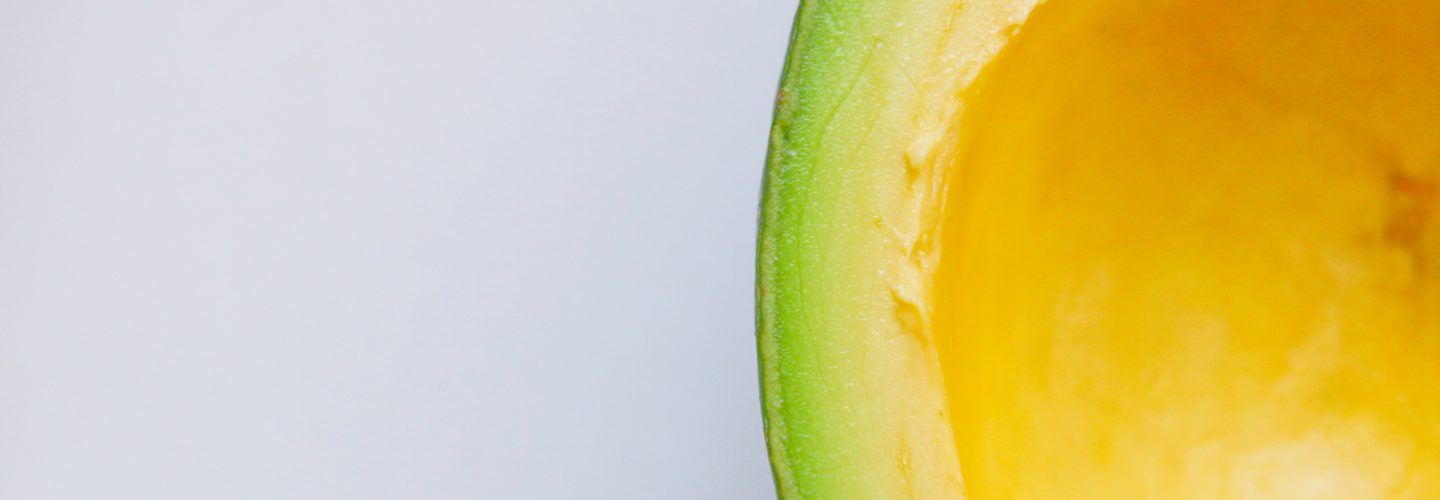
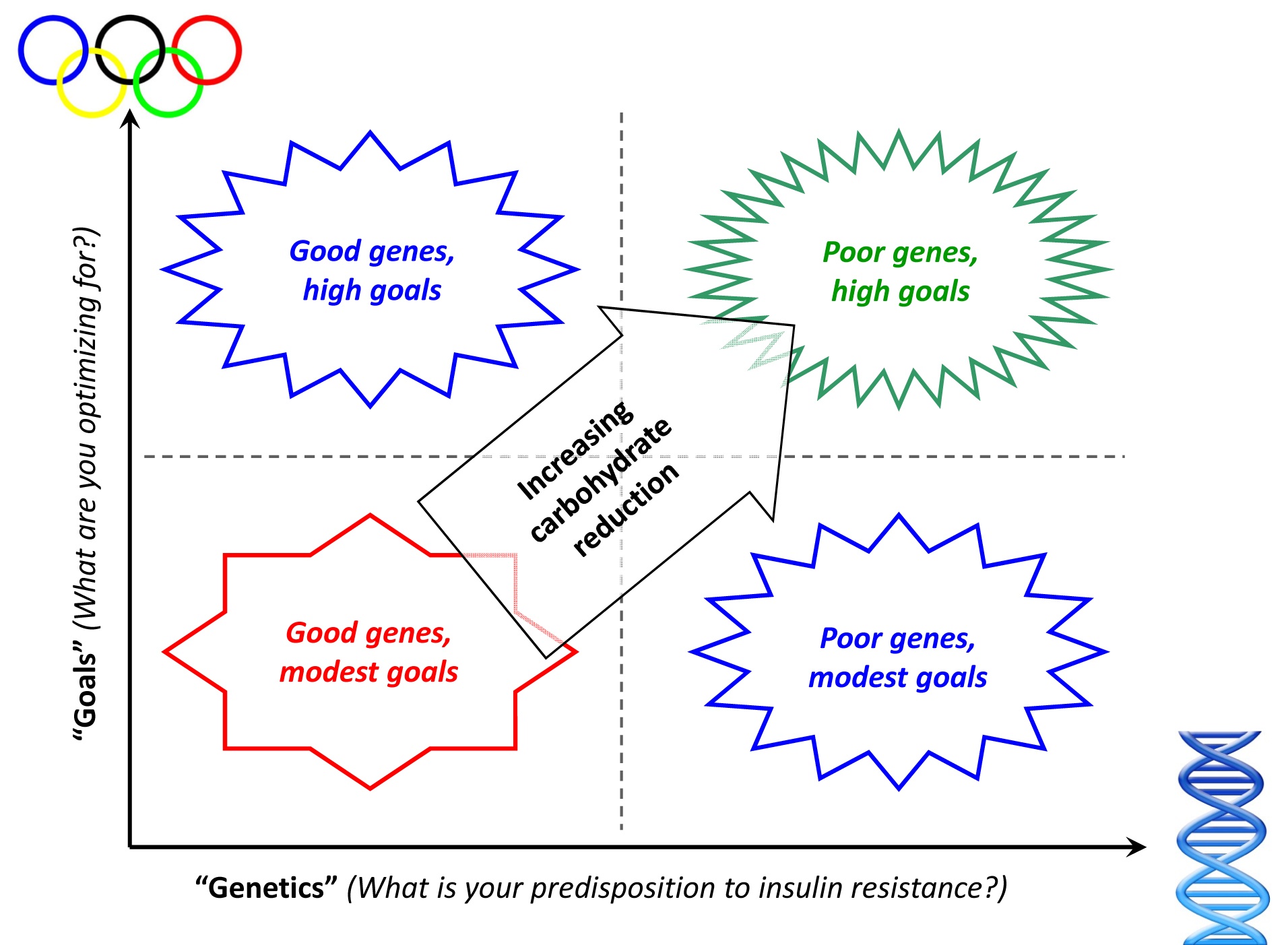

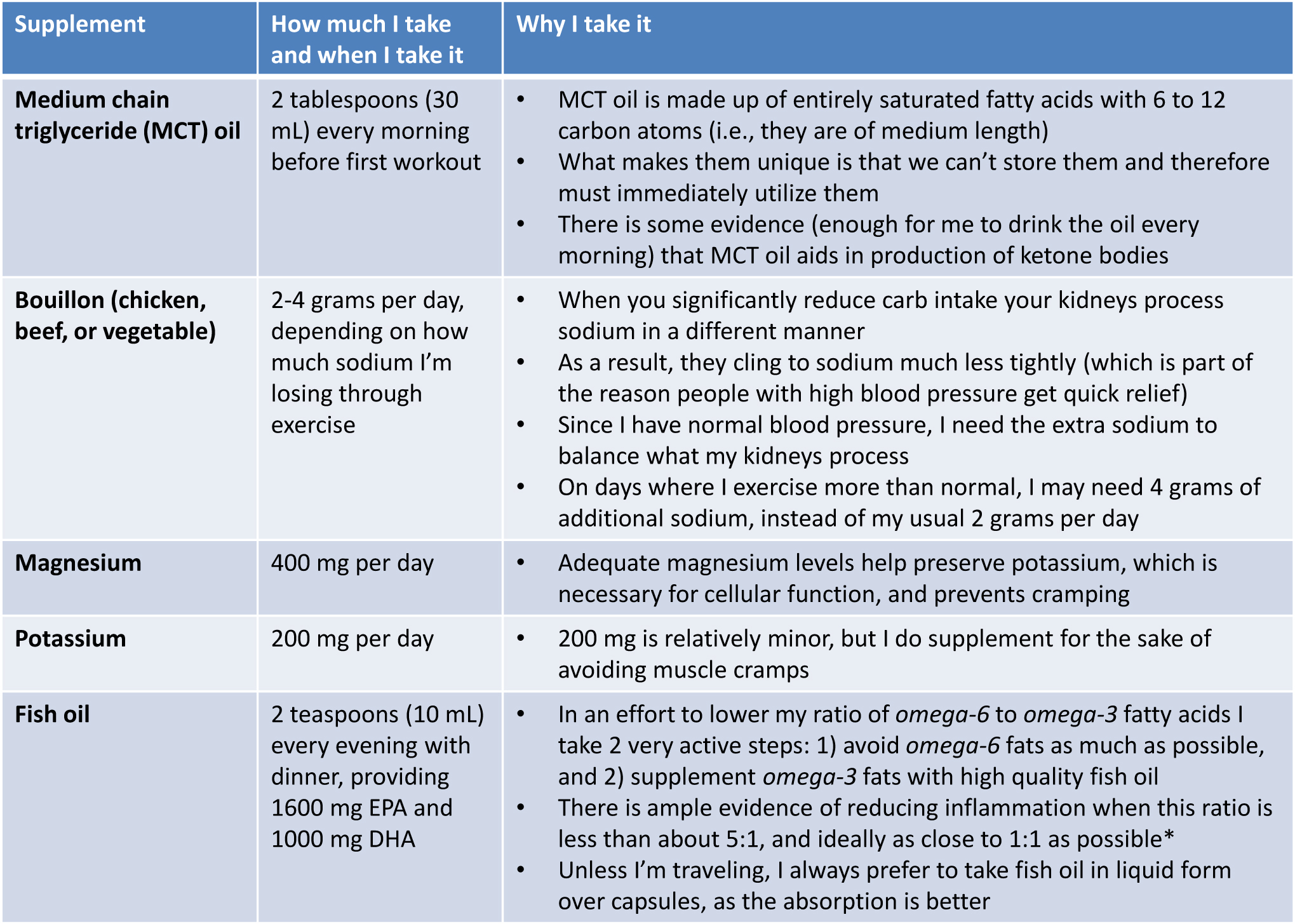
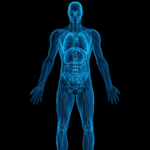


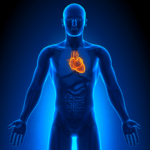
Dear Dr. Attia,
What kind of condiments can I use on the low carb way of eating? Can I use hot sauce, a bag of pork rinds for a snack, lemon juice from a real lemon for fish, pepper, salt, Mrs Dash, different varieties of other spices? Thank you for this wonderful and informative website.
Thanks for any information regarding condiments.
Check the ingredient label. Try to minimize sugar intake.
What about miso instead of bouillon?
Sure, as long you’re getting the sodium.
Miso is pretty high in carbs, 21% nett carbs. Sodium is pretty high though.
I have been eating less than 50g of carbs per day since 23 Mar 12. I average about 34g/day. I’ve been religiously tracking everything. At first weight loss was rapid and I lost 8 lbs in the first 2 weeks. However, for the past week and a half I haven’t lost anything. My sodium intake averages 4.3g/day and I do not exercise strenuously. I was thinking that my protein intake may be too low. I average about 120g/day, but estimate my lean body mass to be about 160-165 lbs so I guess I should be getting 150g of protein /day. Does it make sense that I stopped losing weight because I’m not eating enough protein? I would have thought I’d lose weight by losing muscle or something.
Oh and my calories are on average 2000/day and my fat intake is typically at 145g-150/day.
Rosalee,
Obviously I’m not the expert here, but I would have thought that your protein consumption is too high compared to your fat. If you look at the breakdown of what Peter is eating, your protein levels are almost the same as his are, and yet his fat is 400-425g. This is fine if you have extreme energy requirements as Peter does (and mentions), but with lower energy requirements, and lower fat, the protein also needs to be reduced to maintain the ratio.
I work on 80% fat, 15% protein and 5% carbs. In most cases if I maintain that ratio, regardless of the actual count, I am likely to lose weight or in the least maintain. I find that if my protein goes up to 25-35% of the ratio, with fat being the sacrifice, I will gain weight… not much though.
Hi Peter, great website with super info that I discovered through a podcast at Ben Greenfield.
My question is how conserned I should be about the carbohydrates in nuts and seeds. These things are filled with nice fats and I use them frequently as snacks, but ex. almonds are 20g carbs/100g so the 30-40 g carb limit is very easy to exceed.
Thanks for an interesting blog !
They are much better than the carbs in bread, pasta, and cereal, which are almost always made worse by the addition sugar. Not all carbs are created “equal.”
but even though these carbs are the “good guys” they still are carbs and needs to be counted as a part of the recommended daily maximum intake rigth (30-40g)?
I keep total below 30-40, and all of my carbs are “good guys.” I eat zero “bad guys.” In other words, all my carbs are from nuts, veggies, *trace* fruit, and dairy.
Brian,
Don’t forget to remove the fibre grammage from the carbs with nuts. You then end up with the nett carbs and a more accurate carb count.
I understand that nett carbs should be carbs – fibre – polyols = nett carbs.
Happy to be corrected if I am wrong though.
I am currently experimenting with only eating Brazil nuts with my other meals. Brazil nuts have a really good amount of fat, low nett carbs and less protein than peanuts.
Hi Peter,
Rather than supplement with Bouillon for extra sodium, could one just use extra salt on their food?
Thanks,
Eric
Sure, but for most it’s just easier to use lots of salt on food AND add about 2 gm of sodium via bouillon.
Eric, Peter…I have been salting my food but am still getting massive headaches after training. I tried putting a pinch of salt in the post-traing water I drink and this seemed to help (although just a bit). I’m also supplementing magnesium.
Could drinking over 2 liters of water per day, as do most who train regularly, further increase the need for salt?
I haven’t been through your whole blog yet, so may be missing this somewhere, but how do you KNOW you are ketotic? Do you measure ketone concentration daily in urine or something?
Yes. I measure B-OHB in my blood.
Thanks Travis, I’ll try and up my fat intake even more. I find it hard to add more fat without adding some carbs unless I just want to drink oil lol. Avocados have more carbs than I would expect and all of the cream I have found has a least 1g of carbs per tbsp.
This is so frustrating, I’ve actually gained weight this week. According to the old calories in- calories out model I should have lost 2 lbs. Glad I read Gary Taubes’ Why We Get Fat? because otherwise I would be freaking out and going back to my carbs right about now.
I’m going to try this for another 2.5 months before I decide whether it is worth it. I am looking forward to becoming fully keto-adapted, I don’t like that my muscles seem to burn now just from walking the usual 3 flights of stairs in my building.It makes me feel like an old lady and I’m only 30!
Rosalee,
You could also try reducing your protein intake at the same time to balance out the ratio. My point of the original comment was that your protein level is the same as Peter’s, but with a much lower fat intake. But he is requires the higher fat and protein levels due to the energy output he has, namely the 2-3hrs of fairly intense exercise per day he does. If you do not have the same energy requirements, by increasing the fat intake and leaving the protein where it is, you will likely be eating too much food. By that I don’t mean that you will be eating too much calories, but just physically too much food.
For me, when I eat too much food, even with the correct ratio, I fell too bloated and stuffed rotten. It ends up making me feel lethargic and extremely low in energy. By eating only when you are hungry and not eating until you feel overfull, but at the same time sticking to the ratio, you start to work out the correct levels of each nutrient type to provide you with enough energy and not feel overfull. When I overeat I gain weight, typically because at the same time I do not increase my energy output.
Hi Peter,
besides minerals, is there any Vitamins that you don’t get through your diet and therefore need to supplement?
No.
Hi Peter,
There were some posts about processed meats here. We were talking about this some on a lc/hf recipe group. Here are a couple of articles we found.
https://www.westonaprice.org/blogs/kdaniel/2012/03/29/save-your-bacon-sizzling-bits-about-nitrites-dirty-little-secrets-about-celery-salt-and-other-aporkalyptic-news/
https://m.theglobeandmail.com/life/health/new-health/health-news/ottawa-mulls-new-labelling-rules-for-natural-deli-meats/article2211884/?service=mobile
Will eating this way reverse my heart disease, and my one 70% blockage in one of my heart arteries? Thanks for any information.
If we believe that drugs that lower LDL-P reverse heart disease, then a diet that can reverse LDL-P should have an effect, also. The key, of course, is measuring your current risk (i.e., LDL-P) and evaluating if the treatment has an effect (i.e., is your diet changing it).
You are not concerned about all the cholesterol you consume with sour cream, steak, cheese, butter, and egg yolks? I’m curious to hear a doctor’s explanation on how cholesterol in our diet affects us.
This is a great question, Nathan, and I’ll be writing SO MUCH on this topic in the future. I can’t do this topic justice right now except to say the following: the cholesterol we eat (called endogenous cholesterol) has little, if any, bearing on exogenous cholesterol production (that produced by our bodies). It’s this exogenous cholesterol we need to prevent from getting into our artery walls.
Peter don’t you have your endo’s and exo’s mixed up?
Not sure what I wrote, but it wasn’t that exogenous is what we eat and endogenous is what we make, then I apologize for the confusion.
Hi Peter-
Firstly thank you so much for sharing your knowledge and insights on this blog- I have no idea how you find time to do it with the demands of family, work and training as well but I am just so grateful that you do. I am in Australia and have found it very difficult to find any sensible and medically informed advice on this subject – so this amazing! Just a couple of questions.
1. I think I understand the principles of eating fat in a ketogenic diet, which is what I am following, but what role do you think fat should play in the diet of the rest of the family who do not have same IR issues that I do? What if the kids are eating a meal with potato? Assuming portion size of potato remains the same, is it in fact better to add butter and milk and make mash potato, or to roast it in suitable fat- or does this just add calories when the carb load from the potato is the same? If your insulin levels are raised by the carbs in the potato, does that have an impact on how the fat you eat with it is metabolised?
2. Probably a dumb question- but can people put on weight when eating a ketogenic diet? If someone was eating nearly all fat but well in excess of their daily calorific requirements, would they then start to store that energy as fat? Or would they just burn it off thru digestion, exercise etc?
Good questions.
1. If eating carbs and fats, it’s more likely you’ll store the fat than burn it.
2. Yes, even on a ketogenic diet it is possible to create a positive energy balance.
Update – I’ve broken through the 3 week plateau! Yay! I think I was overeating but did not realize it because I’ve been doing it for so long. I think it stems from being gluten intolerant and my body was always sending signals to my brain that it was hungry because it was never getting any nutrients. My Dr. originally suspected celiac disease/gluten intolerant when I was deficient in just about every nutrient, mineral, neurotransmitter, hormone, you name it despite eating lots of veggies and taking a variety of vitamins and supplements. So when I went low carb/high fat and felt satiated for the first time in a long time, I didn’t realize that I didn’t need to eat as much to feel that way.
I reread the FMBF book by Tom Venuto that I had purchased a few years ago and discovered that my basic metabolic rate was way different then what fitday had suggested. It now makes sense that I wasn’t losing weight because I was eating enough to be at a maintenance level.
All that to say, I am so grateful for this blog and the encouragement to experiment because without that I probably would have given up, thinking it doesn’t work, and gone back to my old way of life. So thank you so much Peter and everyone who posts here! 🙂
Peter,
I’m wondering if I’ve missed a discussion on your blog somewhere about carbs in coffee and heavy cream – I’ve been looking, but haven’t found it, so my apologies if I’m repeating something.
Do you address the number of carbs in heavy cream and coffee somewhere? I read today that coffee has 1 g carb/10oz, and heavy cream 1g/tbsp. that’s alot when you drink coffee laced with lots of heavy cream the way I do! Is there some conversion here with the cream that I don’t understand, or do we really get 16 g carbs/cup of cream? and the coffee? Thanks.
1 cup of heavy cream (whipping cream) in liquid form has 88 gm of fat (55 gm of which are saturated), 5 gm of protein, and 7 gm of carbohydrate. About half that carb is turned into lactate, which doesn’t really “act” like a carb, insulin-wise. Standard brewed coffee has not a gram of any carb/protein/fat.
Dr.A: My Livestrong food database, and other cal-count sources I use, list one cup of coffee as anywhere from .3 to .8g carb, which isn’t much unless like me you drink coffee by the pot. As a person who has to be very strict, less than 30g daily, I do count my coffee just to err on the safe side. Same with eggs, cream, and other food with negligible carbs.
Great webpage!
Thank you for your response. I was having a hard time staying on-line, so I was rushing and didn’t add that I’ve seen several different carb amounts for both coffee and heavy cream. I figured the cream might have something else going on (the conversion issue) but I was really puzzled by the carbs listed in coffee!
This is another reason your website is so important for people trying to do low-carb. There is a ton of confusion out there, including among nutritionists and dieticians. I find your information trustworthy since I know you not only have a medical background, but you’re delving in deeply because of your personal committment.
So thanks again.
fat shake is awesome, but also mildly terrifying.
It’s getting up near 1,000 calories (800 just in the cream, according to my container). I’m all up to speed on the problems with focusing on calories-in-calories-out, and the basic biochem at play. But I’m still pretty struck by how easily that many calories goes down (it does produce incredibly lasting fullness though).
Anyway, this leads to a more general question about physical activity–do you think you’d get fat if you ate what you eat above without much exercise (or something significantly less than 4 hrs/day–way, way out of the realm of most of your readers experience, I’m sure)?
Almost certainly, but if I wasn’t doing any exercise my appetite would be a fraction of what it is. Most people, if eating the *right* foods, are fine if they are truly guided by their appetite. On days I’m traveling on not working out, I typically eat less.
Hey medstudent. I think the fat shake is awesome too, but I’m just not burning enough calories to have it regularly. I do have my own version of it most days for lunch, cutting the heavy cream back to 4 or 5 ounces, with 8 ounces of unsweetened almond/coconut milk, and Peter’s favorite protein powder.
Peter, if you’re already IR, is there a way to differentiate if dairy is part of your problem? The post-prandial insulin is going to be high no matter what was consumed, right?
I know you tested for dairy/xylitol, but if I have the timeline right I think you did this at the point of entering ketosis, when your IR was already resolved. If someone has IR pretty much the same as your original levels on the first OGTT, do you think it meaningful to do a dairy challenge (there’s a lot of dairy in the diet)? Thanks, your thoughts are always very helpful.
Fair point. My second OGTT was before ketosis, but still at a point in time where much of IR had resolved. A dairy challenge is certainly a good idea.
Expanding on Medstudent’s question, I have always tended to overeat. True, in the past it has always been starches that I overate and it has been plainly obvious, but now that I’m doing an experiment of my own, the same patterns seem to apply. The good news is that I do generally feel more satiated during the day, and the 4PM hunger pangs I used to get are completely gone. But I find myself continuing to go “back to the kitchen” after 7 or 8pm, only this time instead of boiling up some pasta, I’m frying up another pork chop. I do exercise 10-15 hours per week, but it’s hard to imagine that’s enough to justify the calories I’m eating. When eating a high fat diet, one can seem to get up above 4000 calories really, really fast.
Anyway, because of the evening habits, while I would love to follow the “let the appetite be your guide” advice, I’m afraid that I’m just prone to overeating regardless of what macronutrients I eat, and might be one of the unlucky people who still has to pay attention to portion sizes, even when attempting ketosis. I’d be interested (and this is my question to you) to know signs you would look for. How would I know if I should NOT let appetite be my guide?
It’s a fair point, and certainly not something I fully understand yet. It’s quite possible to resolve insulin issues, but not leptin issues. Or something else. Some folks may eat more out of “habit” than “hunger.”
One thing that may help shed light on this is tracking what you eat. Not with any attempt to change it, but just to observe it for 4 or 5 days.